Infrared light therapy can help heal your broken bones faster by triggering deep cellular repair mechanisms. When the light penetrates your tissue, it boosts your cells' energy production and increases blood flow to the injury site. You'll experience reduced pain and swelling as the infrared light stimulates natural anti-inflammatory responses in your body. The therapy also enhances collagen formation and bone density by activating specialized bone-building cells called osteoblasts. With regular 10-20 minute sessions, you can substantially speed up your recovery time. There's much more to discover about how this revolutionary therapy transforms bone healing at the molecular level.
Understanding Infrared Light for Bones
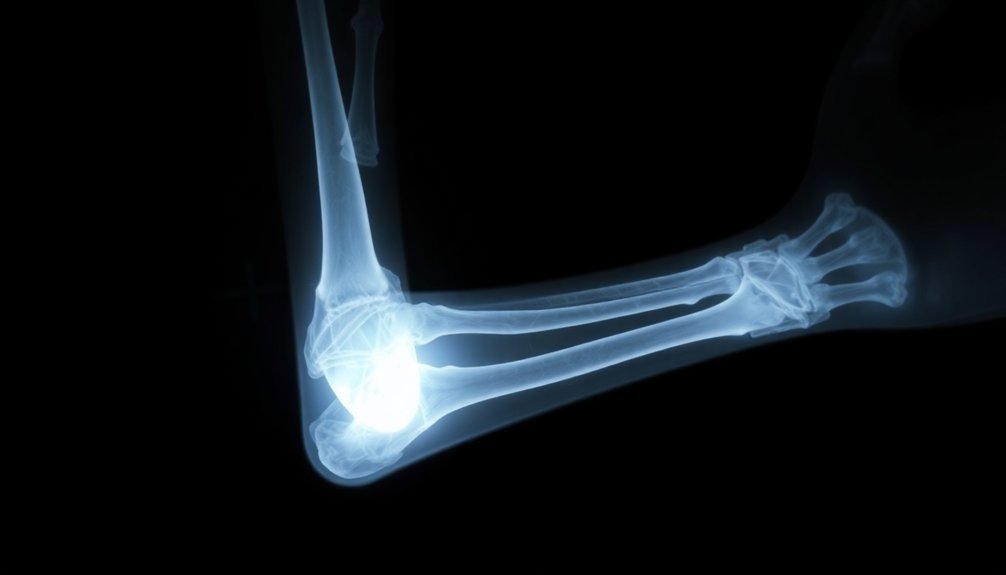
Breakthrough research has revealed the powerful impact of red and near-infrared light therapy on bone health. When you're dealing with bone issues, understanding how this therapy works can make a significant difference in your recovery journey.
Near-infrared light, particularly at wavelengths around 850 nm, penetrates deep into your tissue to stimulate bone healing and regeneration.
You'll find that infrared light works through several mechanisms to improve bone health. It increases bone mineral density by enhancing osteogenesis, which is essential for maintaining strong bones. The light stimulates osteoblast activity – cells responsible for building new bone tissue – while reducing the activity of osteoclasts that break down bone material. This dual action helps create a better balance in bone remodeling. The therapy helps regulate inflammatory response to create optimal conditions for healing.
What makes infrared light particularly effective is its ability to boost collagen production and improve microcirculation in bone tissue. When you're exposed to this therapy, it triggers photobiomodulation, a process that enhances cellular energy production and promotes healing.
The treatment is safe, with minimal side effects, making it an excellent option for supporting conventional bone healing treatments.
Science Behind Bone Healing
Your body's cellular response to light plays a vital role in bone healing, triggering the release of specific growth factors that stimulate bone-forming cells during the repair phase.
During this process, pro-inflammatory cytokines are released to initiate the crucial inflammatory phase of bone healing.
The formation of new collagen, essential for creating the bone's structural framework, accelerates as infrared light penetrates deep into the tissue and enhances cellular metabolism.
These deep tissue healing mechanisms work in harmony with your body's natural bone healing stages, from the initial inflammatory response through the final remodeling phase.
Cellular Response to Light
The intricate science behind infrared light's effect on bone healing stems from its profound influence on cellular activity. When infrared light penetrates your tissues, it triggers a cascade of responses that accelerate bone healing at the cellular level.
Your cells' powerhouses, the mitochondria, respond by producing more ATP (cellular energy), which fuels the healing process. This boost in energy production enables your cells to work more efficiently, supporting tissue repair and regeneration. Low-level light therapy from LED devices or lasers provides the optimal wavelengths for cellular absorption.
You'll also experience enhanced cell proliferation, particularly of osteoblasts and fibroblasts, which are essential for building new bone tissue.
The light therapy's anti-inflammatory effects help create a favorable healing environment by modulating your body's inflammatory response. It reduces excessive inflammation that could otherwise slow down recovery, while maintaining the balanced inflammatory response necessary for proper healing.
Additionally, infrared light stimulates improved blood flow and angiogenesis at the fracture site. You'll benefit from enhanced circulation that delivers necessary oxygen, nutrients, and immune cells to the injured area.
This increased blood supply, combined with new blood vessel formation, provides essential support for bone regeneration and faster healing.
Collagen Formation Process
Bone's intricate healing process begins with a carefully orchestrated series of events centered around collagen formation. When you break a bone, your body immediately initiates an inflammatory response, releasing chemical mediators and forming a hematoma that serves as the foundation for healing. Neutrophils and macrophages arrive to clear debris while fibroblasts begin laying down the initial repair framework.
Your body then shifts to soft callus formation, where mesenchymal stem cells differentiate into chondroblasts and osteoblasts. These specialized cells create fibrocartilage and collagen, forming a temporary bridge across the fracture. The soft callus provides essential stability while your body works on permanent repair.
During this stage, you'll find abundant granulation tissue rich in blood vessels supporting the healing process.
As healing progresses, your osteoblasts transform the soft callus into hard callus through mineralization. This process involves multiple collagen types – primarily types I, III, and V – working together to create the bone's extracellular matrix.
Small leucine-rich proteoglycans regulate this collagen formation, ensuring proper fiber assembly and subsequent mineralization, which ultimately results in strong, functional bone tissue.
Deep Tissue Healing Mechanisms
Scientists have uncovered complex mechanisms driving deep tissue healing in broken bones, revealing a precisely orchestrated process of cellular and molecular events. When you break a bone, your body immediately initiates an inflammatory response, releasing chemical mediators that attract imperative healing cells to the injury site.
The healing process begins with hematoma formation, which creates a natural scaffold for repair.
Your body then mobilizes mesenchymal stem cells (MSCs) that differentiate into specialized bone-forming cells called osteoblasts and chondroblasts. These cells work together to form a soft callus made of fibrocartilage and collagen, establishing the foundation for new bone growth.
You'll find that revascularization plays an essential role in this process. New blood vessels form through angiogenesis, delivering oxygen and nutrients necessary for healing.
This network of vessels supports the development of granulation tissue, rich in fibroblasts and blood vessels. Whether your bone heals through direct or indirect mechanisms depends on the fracture's stability and blood supply.
In direct healing, bone fragments that are perfectly aligned and compressed heal without callus formation, while indirect healing involves both endochondral and intramembranous processes to rebuild your bone structure.
Benefits for Fracture Recovery
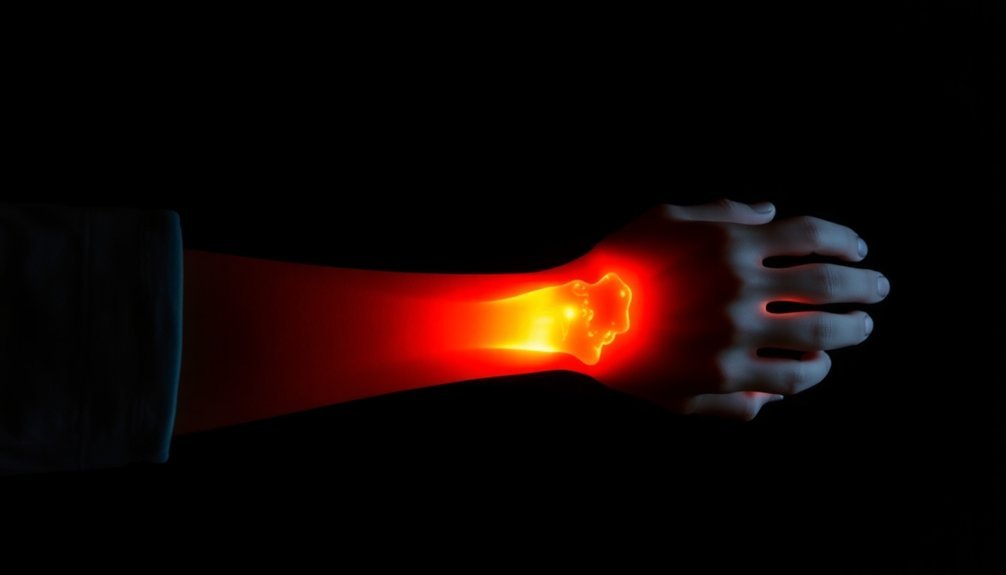
You'll notice significant improvements in healing speed when using infrared therapy for broken bones, as it stimulates cellular energy production and enhances bone tissue formation.
The therapy's ability to boost blood circulation and control inflammation helps reduce both pain and swelling during your recovery process.
Your healing time can be cut shorter through infrared's dual action of accelerating bone regeneration while simultaneously managing discomfort.
Faster Healing Time
Red light therapy's remarkable ability to accelerate bone healing stands out as a game-changing treatment for fracture recovery. When you undergo this therapy, you'll benefit from enhanced cellular activity that directly speeds up the healing process.
The treatment stimulates your osteoblasts – the cells responsible for building new bone tissue – leading to faster bone formation and improved density.
You'll experience accelerated healing through multiple mechanisms. The therapy increases blood flow to your injury site, delivering essential nutrients and oxygen more efficiently. It also boosts collagen synthesis, which is essential for proper bone matrix formation.
Additionally, you'll benefit from the therapy's ability to regulate inflammation, creating a favorable environment for bone repair.
Clinical trials have consistently shown that you can expect significant improvements in healing times compared to conventional treatment alone. The therapy's non-invasive nature means you won't face additional recovery time from the treatment itself.
Whether you're dealing with a simple fracture or a complex break, red light therapy can help reduce your overall recovery period while promoting stronger bone formation. This makes it an invaluable tool in your healing journey, potentially getting you back to normal activities sooner.
Pain and Swelling Control
Managing pain and swelling effectively becomes crucial when dealing with broken bones, and infrared therapy offers powerful relief through multiple pathways.
When you're exposed to infrared light, it triggers your body's natural pain-fighting mechanisms by stimulating endorphin release and blocking pain-transmitting chemicals. The therapy also penetrates deep into your tissues, providing soothing warmth that helps alleviate discomfort.
The treatment's anti-inflammatory properties work to control swelling through several mechanisms. It enhances your lymphatic system's activity, which helps remove excess fluid from the injury site.
You'll experience reduced edema as the therapy improves blood circulation and microcirculation around the fracture. The far-infrared effects specifically target swelling by accelerating lymphatic drainage and modulating inflammatory responses.
Clinical evidence supports these benefits, with numerous studies showing significant improvements in both pain management and swelling reduction.
The therapy's photobiomodulation effects stimulate cellular energy production while regulating inflammation at a molecular level. By increasing ATP production and enhancing blood vessel formation, infrared therapy creates an ideal environment for your body to manage pain and control swelling throughout the healing process.
Deep Tissue Penetration Methods
Through various infrared technologies, deep tissue penetration has become increasingly sophisticated in treating broken bones and other conditions.
Near-infrared (NIR) light offers particularly effective penetration through tissue, with three distinct optical windows ranging from 650-1870 nm that allow for deep therapeutic reach. You'll find that the second and third NIR windows provide even clearer imaging and longer attenuation lengths compared to the first window.
You can benefit from far-infrared (FIR) therapy, which penetrates deep into tissues without heating the surrounding air. FIR wavelengths (3-100 μm) improve your microcirculation by expanding small blood vessels, increasing blood flow to injured areas.
For precise treatment, Gallium Arsenide lasers operating at 904-905 nm can reach impressive depths of 3-5 cm, with some versions penetrating up to 10-14 cm through superpulsing technology.
When you're receiving treatment, the effectiveness depends on several factors. Direct skin contact maximizes penetration by reducing reflection and refraction. While higher intensity enables deeper penetration, your healthcare provider will carefully control the power to avoid excessive heating while ensuring therapeutic benefits reach the injured bone tissue.
Collagen Production and Bone Growth
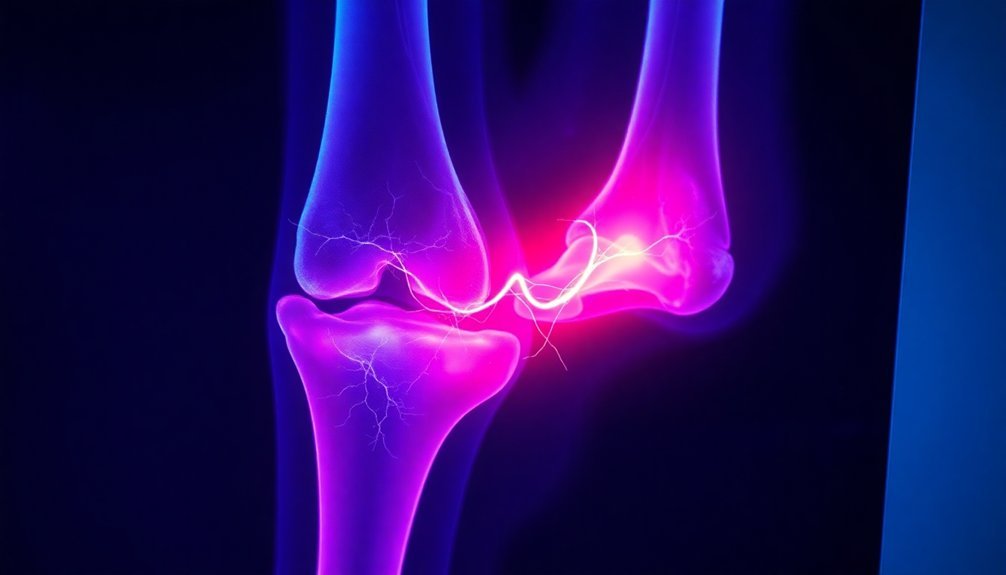
Light therapy's remarkable impact on collagen production makes it a powerful tool for accelerating bone healing. When you receive red and infrared light therapy, it stimulates your fibroblasts, which are cells responsible for producing collagen – a vital protein for bone strength and repair.
This increased collagen synthesis directly supports your bone's healing process and helps create stronger tissue.
The therapy doesn't just boost collagen; it also enhances bone growth by stimulating osteoblasts, the cells that form new bone tissue. You'll benefit from improved bone mineral density and increased bone neoformation compared to untreated bones.
The light therapy also regulates inflammation, making it easier for your body to heal properly.
Your body's natural tissue remodeling process gets a significant boost from infrared therapy. The treatment guarantees proper collagen alignment and creates stronger, more resilient tissue that's less likely to be injured again.
Clinical trials have consistently shown these benefits, making infrared light therapy an effective non-invasive treatment for bone healing. It's particularly promising for conditions like osteoporosis, where it can help preserve bone strength and stimulate new bone formation.
Blood Flow Enhancement Mechanisms
Deep within injured bone tissue, infrared therapy triggers multiple mechanisms that enhance blood flow and accelerate healing. When far-infrared light penetrates your tissues, it creates a warming effect that promotes local vasodilation, increasing blood flow to your injured area without heating the surrounding air.
You'll benefit from improved circulation as infrared therapy breaks apart water clusters in your blood, enhancing oxygen delivery to the wound site. The red and near-infrared wavelengths stimulate energy production in your bone cells, encouraging the formation of new blood vessels and promoting better circulation throughout the healing area.
As blood flow increases, your injury site receives more oxygen and essential nutrients, which are essential for tissue repair. This enhanced circulation helps reduce swelling and inflammation while supporting ideal fibroblast activity and collagen alignment.
The therapy's ability to improve microcirculation plays a critical role in tissue remodeling and healing.
Near-infrared spectroscopy can monitor these improvements in blood flow and oxygenation, helping track your healing progress. The combination of enhanced circulation and cellular response creates an ideal environment for bone repair and tissue regeneration.
Pain Management Through Infrared
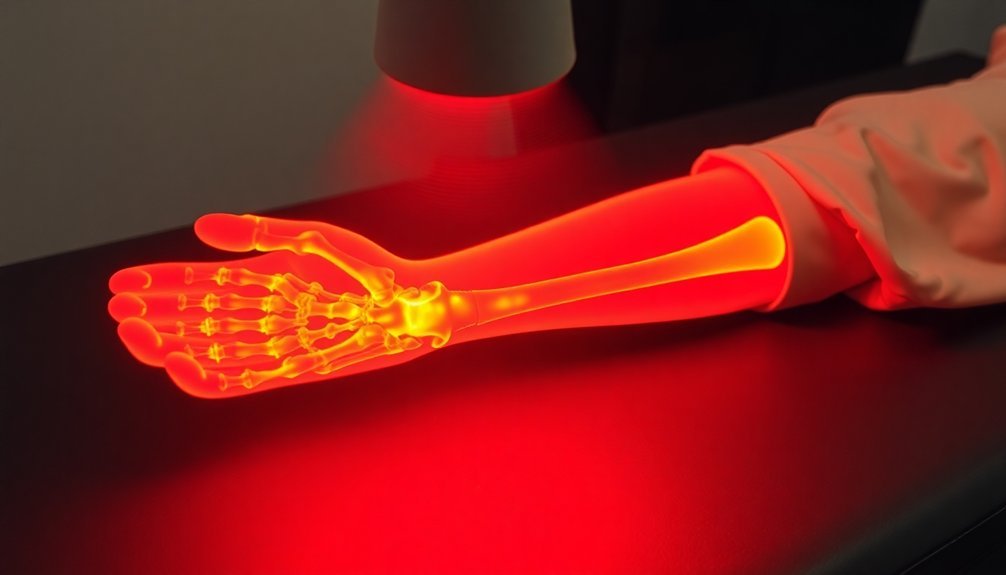
Infrared light therapy offers you rapid relief from broken bone pain through its powerful anti-inflammatory effects and natural endorphin release.
You'll experience pain control at deep tissue levels as the infrared waves penetrate beneath the skin's surface, disrupting pain signals to your brain while simultaneously promoting healing.
The therapy's ability to enhance blood circulation and reduce inflammation in the affected area means you can get meaningful pain relief without relying on opioid medications.
Immediate Relief From Discomfort
Modern science has revealed the remarkable pain-relieving capabilities of infrared therapy for broken bones and related injuries. You'll experience relief through multiple mechanisms as infrared light triggers your body's natural healing responses.
When you undergo infrared therapy, it stimulates your body's production of endorphins, which act as natural painkillers to reduce your discomfort.
The therapy works by boosting your nitric oxide production, which relaxes your arteries and enhances blood circulation to the injured area. You'll benefit from increased oxygen and nutrient delivery to your damaged tissues, which speeds up cellular repair and reduces inflammation.
The improved blood flow also helps manage swelling around your broken bone, making movement less painful.
You can access this relief through portable, hands-free devices that deliver targeted infrared therapy whenever you need it. There's no need to worry about side effects, as it's a non-invasive treatment that complements traditional bone healing methods.
The therapy's ability to stimulate collagen production also supports your bone's healing process while providing sustained pain relief throughout your recovery period.
Deep Tissue Pain Control
Building on the immediate pain relief benefits, the power of infrared therapy extends far beneath your skin's surface to address persistent deep tissue discomfort. When you receive infrared treatment, the light penetrates 2-7 centimeters deep, reaching your muscles, nerves, and bones where the pain originates.
The therapy works through multiple mechanisms to control your deep tissue pain. It stimulates your cells' cytochrome C oxidase, enhancing mitochondrial function and boosting ATP production. This increased cellular energy helps repair damaged tissues while disrupting pain signals traveling to your brain.
You'll also experience natural pain relief as the treatment triggers your body's endorphin release.
What makes infrared particularly effective for bone-related pain is its ability to increase blood flow by up to 400% within just 30 minutes. This enhanced circulation delivers oxygen-rich blood to your injured area, reducing inflammation by balancing cytokines.
The therapy also relaxes your muscles and reduces spasms, which often accompany bone injuries. If you're experiencing nerve pain around the fracture site, you'll benefit from infrared's ability to treat peripheral neuropathy through its deep-penetrating properties.
Healing Time and Recovery
Bone fractures typically take 6-8 weeks to heal, but you can substantially reduce this timeline with infrared therapy. Your body's natural healing process involves inflammation, soft tissue repair, and bone regeneration – all of which are enhanced through red and near-infrared light.
This therapy works by improving blood flow, boosting collagen synthesis, and increasing ATP production in your bone cells.
During your recovery, you'll experience several key benefits that accelerate healing:
- Enhanced tissue regeneration and improved blood vessel formation, which speeds up the initial healing phase
- Increased collagen production and better alignment of fibroblasts, leading to stronger bone repair
- Reduced inflammation and pain, allowing for more comfortable movement during recovery
Your healing process becomes more efficient with consistent infrared therapy applications, typically requiring less than an hour daily over the affected area.
Even challenging cases like non-union fractures, which traditionally have slower healing times, show significant improvement with infrared treatment. You'll notice faster recovery times and better overall results, especially when the therapy is applied early in the healing process.
Clinical Research and Results
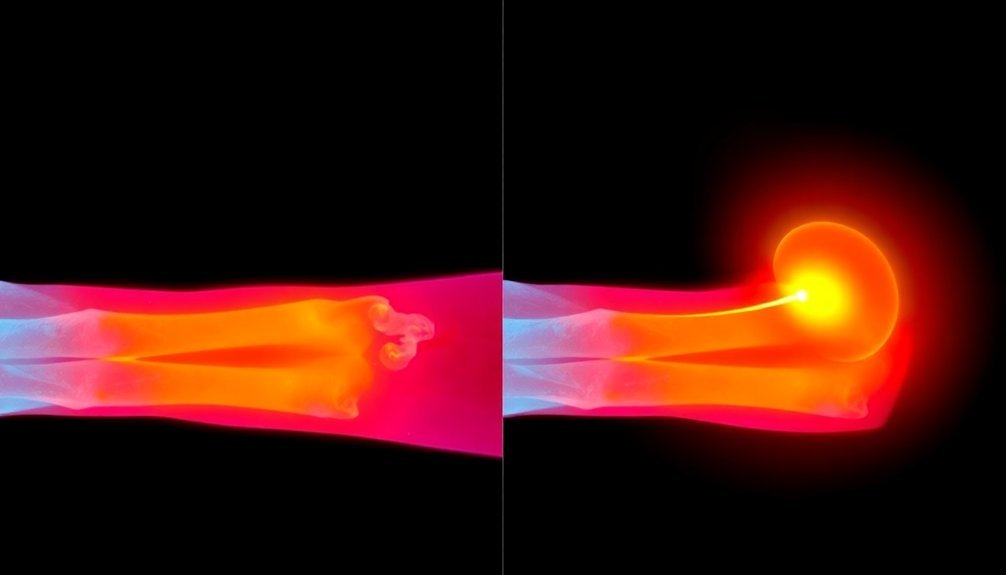
Examining the clinical evidence reveals impressive results for infrared therapy in bone healing. Research shows that red light and near-infrared therapy increase bone mineral density while enhancing osteogenesis, which directly contributes to stronger bone formation. These therapies accelerate healing in various bone-related conditions, from simple fractures to complex extraction sites.
Near-infrared light stimulates several essential healing mechanisms. It boosts collagen production and ATP generation in bone cells, while promoting osteoblast activity – the cells responsible for new bone formation. Studies demonstrate that this leads to reduced healing times and improved tissue strength.
The monitoring of these healing processes has become more sophisticated through near-infrared spectroscopy (NIRS). You can now track your bone healing progress through non-invasive measurements of tissue oxygenation and hemoglobin levels. This technology helps detect potential complications early, allowing for timely interventions.
Far-infrared therapy complements these benefits by enhancing blood circulation and reducing inflammation. It expands blood vessels to increase oxygen delivery and supports ideal tissue remodeling, making it an effective component in thorough bone healing protocols.
Treatment Sessions and Duration
The success of infrared therapy relies heavily on a well-structured treatment schedule. You'll need to commit to regular sessions lasting 10-20 minutes, typically occurring 2-3 times per week for the best bone healing results.
Research shows that consistent treatment over 11-12 weeks can markedly accelerate the healing process, which traditionally takes 6-8 weeks without intervention.
For the best healing outcomes, you'll need to follow a specific treatment protocol based on your fracture type and severity. Your healthcare provider will determine the appropriate energy density, often around 5 J/cm², and may combine infrared therapy with other treatments like Sarmiento functional bracing.
Here are key factors to take into account for your treatment schedule:
- Frequency: Attend sessions 3-5 times per week for maximum effectiveness
- Duration: Each session should last 10-20 minutes
- Commitment: Maintain consistency for 11-12 weeks, as interruptions can reduce healing benefits
Remember that while treatment schedules may vary slightly between providers, maintaining consistency is vital for achieving the desired healing outcomes. Your healthcare provider will monitor your progress and adjust the treatment parameters as needed throughout your healing journey.
Combining Therapies for Best Results
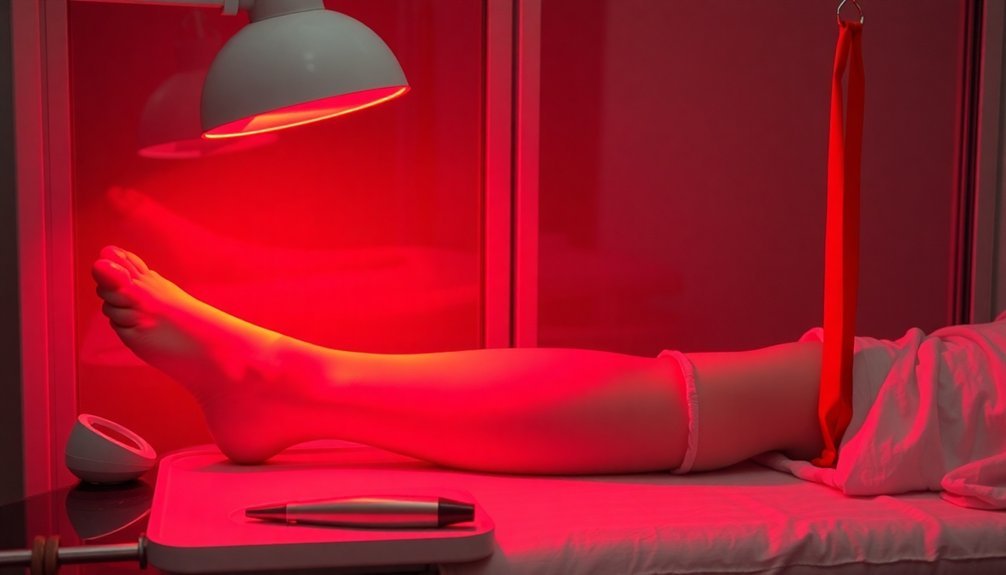
Medical experts agree that combining infrared therapy with other treatment modalities can substantially boost your healing outcomes. When you combine near-infrared light therapy with traditional treatments, you'll experience accelerated bone healing through enhanced collagen synthesis and improved tissue remodeling.
| Treatment Combination | Benefits |
|---|---|
| Surgery + Infrared | Accelerates healing and enhances callus formation |
| Physical Rehab + Infrared | Improves muscle, connective tissue, and bone recovery |
| BMPs + Infrared | Increases bone regeneration effectiveness |
| Conventional Wound Care + Infrared | Enhances overall tissue repair process |
You'll get the most benefit by integrating infrared therapy into your thorough treatment plan. The therapy works at the cellular level by stimulating mitochondrial energy production, which speeds up bone cell metabolism. It'll also help reduce inflammation while promoting better blood flow and waste removal. When combined with treatments for conditions like osteoporosis, you'll notice improved bone density as the therapy suppresses sclerostin, a protein that typically inhibits bone formation. Research consistently shows that this multi-modal approach leads to faster recovery times and more complete healing outcomes.
Safe Usage Guidelines and Tips
While combining therapies enhances healing outcomes, understanding proper safety protocols guarantees you'll get the most benefit from infrared treatment.
You shouldn't use infrared therapy if you have impaired skin sensitivity, poor circulation, or active skin conditions like dermatitis. It's also vital to avoid treating areas with tumors or previous radiation damage.
If you're using a red light or near-infrared device, make certain it meets ISO 13485 standards and delivers wavelengths between 780-1000 nm, with bone healing specifically benefiting from 850 nm wavelengths. You'll need to inform your healthcare provider if you have metal implants or experience fever before starting treatment.
- Monitor your treatment duration – stick to 10-minute sessions, five times weekly for two weeks
- Check your skin's response during and after treatment – stop if you experience unusual sensations or reactions
- Keep the device at the recommended distance from your skin, and don't exceed prescribed treatment times
If you have photosensitivity or hyperesthesia, you'll need special consideration before starting treatment. Always follow your healthcare provider's instructions and stop treatment if you experience any adverse reactions.
Frequently Asked Questions
Can I Use Infrared Therapy if I Have Metal Implants in My Bones?
Yes, you can safely use infrared therapy with metal implants in your bones. Studies show it's effective for reducing post-operative discomfort and improving healing around implant sites without affecting the metal hardware itself.
Does Infrared Therapy Work Differently on Children's Growing Bones Versus Adult Bones?
Yes, infrared therapy works differently on your growing bones as a child versus adult bones. You'll see faster healing and enhanced bone growth in children, while adults mainly experience improved bone density and repair.
Will Infrared Therapy Affect the Bone Density Readings on My X-Rays?
Yes, your X-ray readings may show increased bone density after infrared therapy. You'll likely see these changes over time as the treatment enhances mineralization and stimulates bone cell activity in treated areas.
Can Infrared Treatment Interfere With Bone-Strengthening Medications I'm Taking?
While there's no clear evidence of interference between infrared therapy and bone-strengthening medications, you'll want to consult your doctor before combining treatments. They can monitor your specific case and guarantee safe, effective treatment.
Should I Wait Until My Cast Is Removed to Start Infrared Therapy?
No, you don't need to wait. You can start infrared therapy immediately, even with your cast on. While the light can penetrate through the cast, it's still effective in promoting bone healing and reducing pain.
In Summary
You've learned how infrared therapy can aid bone healing through deep tissue penetration and enhanced collagen production. While it won't replace traditional medical treatments, infrared light can complement your recovery process by increasing blood flow and reducing inflammation around fracture sites. Remember to follow proper treatment protocols and consult your healthcare provider before starting any infrared therapy for broken bones.





Leave a Reply